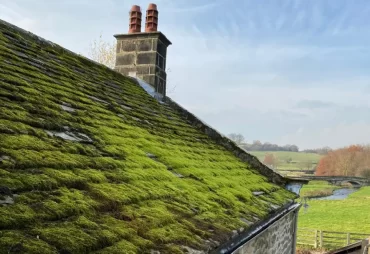
Understanding the cause of moss and algae buildup on your roof is important, and is essential for the prevention, treatment, and its long-term health and durability. It is common for roofs to have moss and algae issues. They don’t just detract from the appearance of your home; they also negatively affect its structural integrity.
If you live in an area that has frequent rainfall and moderate temperatures, your roof is more apt to have moss and algae growth. If your home is under trees, the lack of sunlight further promotes the growth of moss and algae. A professional roofing contractor will know that areas with higher humidity are more likely to see moss and algae on their roofs. These damp conditions are ideal for these organisms to thrive. We know the territory and are prepared for these conditions.
Protective roof coatings degrade over time. When this happens, the roof becomes vulnerable to moss and algae infestations. The wear and tear from exposure to elements can increase a roof’s susceptibility to these organisms. Ask your roofing contractor which roofing materials are more susceptible to these infestations. Asphalt shingles, with their porous quality, are particularly susceptible. They provide an ideal surface for moisture to remain and provide ideal conditions for moss and algae to grow.
As your roof gets older, it becomes more porous and more susceptible to penetrating moisture. This is the perfect habitat for moss and algae to thrive. When a roof ages, it is more likely to develop moss and algae due to the degradation of its protective coating.
Potential damage to roof structure is a common factor that contributes to moss and algae growth, increasing extensive growth and potential damage to the roof structure over time. Neglecting regular inspection by a roofing contractor, roof cleaning and maintenance is a sure way to invite these damaging intruders.
If your house is situated under an overhang of trees and other vegetation, the resulting organic debris falling and collecting on your roof provides nutrients that cause moss and algae to thrive. This also increases the moisture that can be retained increasing even further a perfect environment for moss and algae growth.
Other factors contribute significantly to water retention and subsequent moss and algae growth. These factors include the flatness of your roof which inhibits water from running off, and even the orientation of your roof to the sun. Sunlight exposure has a direct connection to moisture retention. This alone may influence or increase the likelihood of moss and algae infestation.
A roof’s inability to drain water creates conditions that increase the growth of moss and algae. Water pooling is caused by debris both on the roof and in the gutters, resulting in stagnate environments and clogged downspouts that are a perfect breeding ground for invasive, moisture-loving moss and algae.
The prevention and treatment for moss and algae infestation requires a scheduled plan. Getting your roof inspected by a professional roofing contractor is the starting point. From there you should begin having your roof cleared of debris regularly and treat your roof with several varieties of solutions, some natural and some chemical. These treatments are effective in controlling existing growth and preventing continued infestation.
Several factors encourage the growth of moss and algae on your roof. Some are environmental and some are simply the result of roofing material characteristics and maintenance habits. By knowing the causes and regular prevention measures, homeowners can proactively stay ahead of the problem, prevent long-term damage, and maintain the health of their roof, thus increasing its longevity.
Begin a regular schedule of professional roofing contractor inspection and maintenance and find out how much easier it becomes to stay ahead of the problem. Let a professional inspect your roof, provide an assessment, and recommend preventative measures to keep your roof healthy, attractive, and resilient for many years to come.